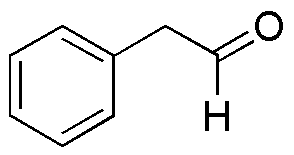Phenylacetaldehyde is widely utilized in research focused on:
- Fragrance and Flavor Industry: This compound is a key ingredient in perfumes and flavorings, providing a sweet, floral aroma that enhances various products.
- Pharmaceuticals: It serves as an intermediate in the synthesis of various pharmaceuticals, contributing to the development of medications that treat a range of conditions.
- Organic Synthesis: Researchers use it as a building block in organic chemistry to create more complex molecules, facilitating advancements in chemical research and development.
- Polymer Production: It is employed in the production of certain polymers, improving material properties and expanding applications in plastics and coatings.
- Agricultural Chemicals: The compound is also used in the formulation of agrochemicals, helping to enhance crop protection and yield.
General Information
Properties
Safety and Regulations
Applications
Phenylacetaldehyde is widely utilized in research focused on:
- Fragrance and Flavor Industry: This compound is a key ingredient in perfumes and flavorings, providing a sweet, floral aroma that enhances various products.
- Pharmaceuticals: It serves as an intermediate in the synthesis of various pharmaceuticals, contributing to the development of medications that treat a range of conditions.
- Organic Synthesis: Researchers use it as a building block in organic chemistry to create more complex molecules, facilitating advancements in chemical research and development.
- Polymer Production: It is employed in the production of certain polymers, improving material properties and expanding applications in plastics and coatings.
- Agricultural Chemicals: The compound is also used in the formulation of agrochemicals, helping to enhance crop protection and yield.
Documents
Safety Data Sheets (SDS)
The SDS provides comprehensive safety information on handling, storage, and disposal of the product.
Product Specification (PS)
The PS provides a comprehensive breakdown of the product’s properties, including chemical composition, physical state, purity, and storage requirements. It also details acceptable quality ranges and the product's intended applications.
Certificates of Analysis (COA)
Search for Certificates of Analysis (COA) by entering the products Lot Number. Lot and Batch Numbers can be found on a product’s label following the words ‘Lot’ or ‘Batch’.
*Catalog Number
*Lot Number
Certificates Of Origin (COO)
This COO confirms the country where the product was manufactured, and also details the materials and components used in it and whether it is derived from natural, synthetic, or other specific sources. This certificate may be required for customs, trade, and regulatory compliance.
*Catalog Number
*Lot Number
Safety Data Sheets (SDS)
The SDS provides comprehensive safety information on handling, storage, and disposal of the product.
DownloadProduct Specification (PS)
The PS provides a comprehensive breakdown of the product’s properties, including chemical composition, physical state, purity, and storage requirements. It also details acceptable quality ranges and the product's intended applications.
DownloadCertificates of Analysis (COA)
Search for Certificates of Analysis (COA) by entering the products Lot Number. Lot and Batch Numbers can be found on a product’s label following the words ‘Lot’ or ‘Batch’.
*Catalog Number
*Lot Number
Certificates Of Origin (COO)
This COO confirms the country where the product was manufactured, and also details the materials and components used in it and whether it is derived from natural, synthetic, or other specific sources. This certificate may be required for customs, trade, and regulatory compliance.


